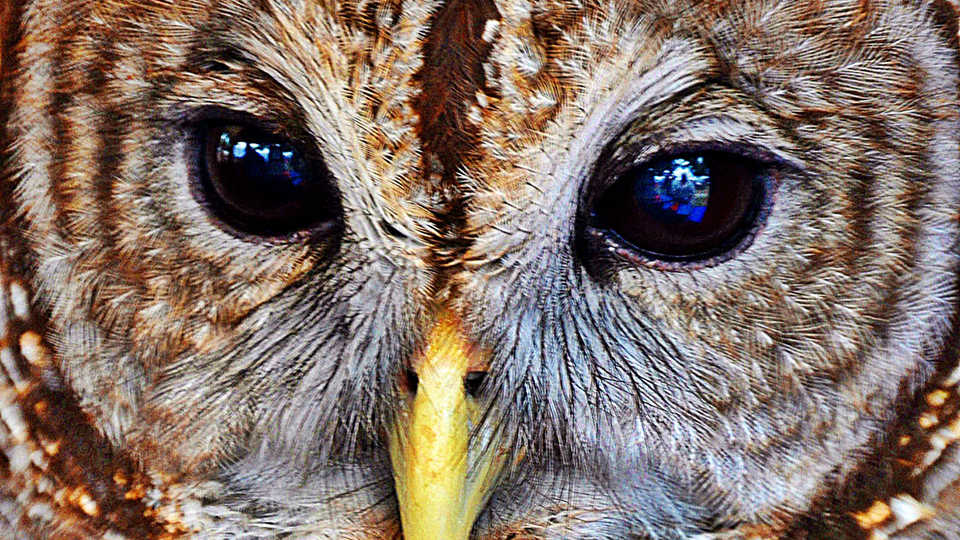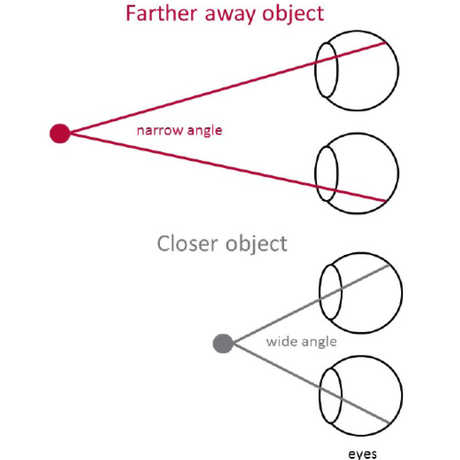
"Eye in You" © 2015 Mike Cofrancesco
Why do humans have two eyes?
In this simple activity students will discover the concept of parallax and start discussing depth perception.
Students will be able to:
- experience how parallax contributes to depth perception.
- explain how the phenomenon of parallax is the result of having two eyes.
- scratch paper
- pencils (1 per student)
- Gather scratch paper for each student.
- Begin by asking students why it might be useful for animals (including humans) to have two eyes instead of one.
- Have students cover one eye and ask if they are still able to see well. Have them brainstorm reasons that two eyes might be an advantage over having just one eye.
- Tell students that they will learn some of the reasons that two eyes might be useful through these activities.
- Give each student a piece of scratch paper and have him or her to roll it up into a tube-shape.
- Have students take the tube in their right hand, hold it up to their right eye, and look through it, as if they are looking through a telescope.
- Now tell students to place their left hand next to the tube about two inches from the far end. Their left hand palm should be facing toward the student’s face and the edge of the hand should be touching the side of the paper tube. See the next page for a photo of what this looks like.
- Have students keep both eyes open. Tell them to focus their eyes on a distant point on the far wall. As students focus their eyes, they should suddenly see a “hole” appear in the center of the left palm.
Teacher Tip: Some students may require a little help to get the illusion to work. Here are some trouble-shooting tips:
- Make sure that the student has both eyes open and that the hand is not covering the opening of the paper tube.
- Try moving the left hand slowly closer to the face until the illusion comes into focus.
- If that doesn’t help, try readjusting where the eyes are focused. Choose an object on the other side of the room and tell the student to focus his or her eyes on the object. If they are still having trouble, have them choose an object that is closer or farther.
- If none of that works, have the student try switching eyes. Some people can see the illusion more easily with one eye than the other.
- Have students hold a pencil out at arms length.
- Tell students to cover their right eyes and look at the pencil with their left eyes only. Have them note where the pencil is in relation to objects in the background.
- Now tell them to switch eyes (i.e., close the left eye and look at the pencil with the right eye). Ask them what they observe. They should notice that the pencil appears to “jump” from one location to another in relation to background objects.
- Discuss with students why the pencil appear to “jump” when you switch eyes. Since each eye is in a slightly different place, each eye sees a slightly different image. When you switch eyes, you are switching between the two images, and the subtle differences become noticeable.
- Ask students to predict whether the “jump” would be more noticeable or less noticeable with the pencil held closer to the face. Have them turn and talk to their neighbor to compare predictions.
- Now let students test their prediction by repeating the exercise with the pencils held very close to their faces. Ask them what they observe. Does the result fit with their prediction?
- Students should find that there is a larger apparent displacement when the pencil is closer to the face. For objects close to us, there is a big difference in the angles between each eye and the object, so you see the pencil take a big “jump” when you switch eyes. For objects farther away, the angles are much more similar and the “jump” when switching eyes is less noticeable. Our brains use that information to determine how far away objects are.
Discuss the following question as a class:
- Why do we have 2 eyes? (While we do not normally notice parallax, our brains use the phenomenon to figure out how far away things are. The brain takes in what the right eye sees and what the left eye sees and combines the images, as shown by the Hole in Your Hand illusion. At the same time, the brain evaluates the differences between the two images and calculates how far away things are. Objects that show a slight displacement, like the pencil held at arms length, are interpreted as being far away. Objects that show a big displacement, like the pencil held up close, are interpreted as being closer. Our ability to perceive and interpret this information is called depth perception.)
NGSS CROSSCUTTING CONCEPTS CONNECTION: This portion of the lesson connects to the Practice of Constructing Explanations because students are asked to explain how their two eyes created the optical illusion of a hole in the palm of their left hand. To do this, students will have to make one or more claims and support them with scientific reasoning. Don’t worry if students’ claims are a bit far-fetched at this point. The next activity will help them build their understanding of the phenomenon of parallax.
parallax: the difference in the apparent relative position of objects when they are viewed from different perspectives.
depth perception: the ability to visually judge distances.

Here’s a question you may not have given much thought to before: Why do humans (and many other animals) have two eyes? If you close one eye and take a look around, you should find that you can still see everything pretty well. One eye can see with adequate detail, color, and clarity—so what is the point of having the second eye? While it seems that we should be able to get along just fine with only one eye, you will be hard-pressed to find any one-eyed vertebrates. As it turns out, there are some interesting advantages to having two eyes.
Parallax
The advantage of having two eyes is all about location. Our two eyes are located in different places, and as a result have different perspectives on the world around us.
You can see this effect by holding a pencil out at arm’s length. Look at the pencil with your right eye closed and your left eye open. Then switch eyes. It will appear to you that the pencil has changed position in relation to the background. This effect, called parallax, occurs because each eye is viewing the pencil from a slightly different perspective. In many animals, such as humans, both eyes are facing forward and are fairly close together, so the difference in perspectives is small. Even so, the difference is enough to provide the brain with some valuable information.
Depth perception
Take the pencil that you were holding at arms length and hold it much closer to your face. Then repeat the exercise of looking with one eye, then the other. You should observe a larger apparent change in position than when the pencil was farther away from your face. For objects close to us, there is a big difference in the angles between each eye and the object, so you see the pencil take a big “jump” when you switch eyes. For objects farther away, the angles are much more similar and the “jump” when switching eyes is less noticeable. Our brains use that information to determine how far away objects are. While we are not consciously aware of the differences between the images collected by our left and right eyes, our brains are subconsciously sorting through those differences to calculate how far away each object we see is. Our depth perception, or ability to judge how far away things are, depends largely on the fact that we have two eyes viewing the same objects from slightly different perspectives.
NGSS CROSSCUTTING CONCEPTS CONNECTION: This lesson connects to the Crosscutting Concept of Structure and Function because students are asked to think about why it might be useful for animals (including humans) to have two eyes rather than just one. This question prompts students to consider how a particular structure (two eyes) might function better than another (having just one eye). In Parts 1 and 2, students experience firsthand why having two eyes located in slightly different places creates the phenomenon of parallax, which creates depth perception.
The items listed below indicate how the activities support the three dimensions of the Next Generation Science Standards:
- Science and Engineering Practices
- Constructing Explanations
- K-2: Make observations (first-hand or from media) to construct an evidence-based account for natural phenomena.
- 3-5: Use evidence (e.g., measurements, observations, patterns) to construct or support an explanation.
- 6-8: Apply scientific ideas, principles, and/or evidence to construct, revise, and/or use an explanation for real-world phenomena.
- Constructing Explanations
- Disciplinary Core Ideas
- 1.LS1.A: Structure and Function All organisms have external parts. Different animals use their body parts in different ways to see, hear, grasp objects, protect themselves, move from place to place, and seek, find, and take in food, water and air.
- 1.LS1.D: Information Processing Animals have body parts that capture and convey different kinds of information needed for growth and survival.
- 4.LS1.A: Structure and function Plants and animals have both internal and external structures that serve various functions in growth, survival, behavior, and reproduction.
- 4.LS1.D: Information Processing Different sense receptors are specialized for particular kinds of information, which may be then processed by the animal’s brain.
- Crosscutting Concepts
- Structure and Function
- K-2: Students observe the shape and stability of structures of natural and designed objects are related to their function(s).
- 6-8: Students analyze many complex natural and designed structures and systems to determine how they function.
- Structure and Function
Remember, performance expectations are not a set of instructional or assessment tasks. They are statements of what students should be able to do after instruction. This activity or unit is just one of many that could help prepare your students to perform the following hypothetical tasks that demonstrate their understanding:
4-LS1-1. Construct an argument that plants and animals have internal and external structures that function to support survival, growth, behavior, and reproduction. [Clarification Statement: Examples of structures could include thorns, stems, roots, colored petals, heart, stomach, lung, brain, and skin.] [Assessment Boundary: Assessment is limited to macroscopic structures within plant and animal systems.]
4-LS1-2. Use a model to describe that animals receive different types of information through their senses, process the information in their brain, and respond to the information in different ways. [Clarification Statement: Emphasis is on systems of information transfer.] [Assessment Boundary: Assessment does not include the mechanisms by which the brain stores and recalls information or the mechanisms of how sensory receptors function.]
"Eye in You" by Mike Cofrancesco, licensed and modified under CC BY 2.0; originally sourced from https://www.flickr.com/photos/29350563@N08/16502284767/

